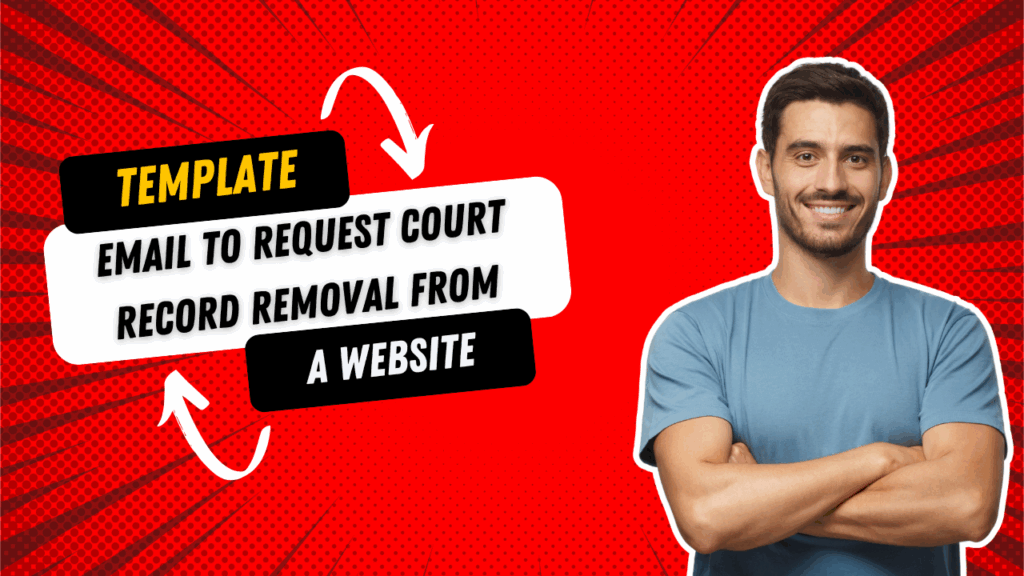Online court records can stay on the internet long after your case is closed. Even if your case was dismissed or resolved years ago, it may still show up on third-party sites. These sites collect public records and publish them, often without your knowledge or consent.
If your court record is listed on one of these websites, you may be able to get it removed. One of the first steps is to send a removal request by email. In this guide, you’ll learn how to write that email, who to send it to, and what to expect.
You’ll also get a customizable template that you can copy and use today.
Dig Deeper: How to Remove Court Records from Google Search
Why websites keep your court records up
Court records are public by default. That means websites can legally republish them unless there’s a law or court order that says otherwise. Some companies pull data from court systems and repost it to make money through ads, subscriptions, or background check services.
The longer the data stays up, the more it can hurt you. It can affect job offers, housing applications, and your reputation.
That’s why sending a takedown request is worth your time—even if it feels like a long shot.
When you should send a removal request
You should email a removal request when:
- Your case was dismissed, dropped, or resolved in your favor
- The record is inaccurate or outdated
- The record was expunged or sealed
- You never gave consent for your name to be published
- The website is not a government site
Sites that only show public info may still honor removal requests, especially if they’re not tied to government databases.
If you’ve already taken legal action or had your record expunged, you have an even stronger case. Keep that proof handy.
How to find the right contact
Look for a “Contact Us,” “Opt-Out,” or “Privacy Policy” link on the site. These pages often list a support email or form for removal requests.
If you can’t find anything, try running this Google search:
site:[website name] removal request OR contact
Example: site:arrestfacts.com removal request OR contact
Still nothing? Use a WHOIS lookup (like whois.domaintools.com) to find a general contact email.
What to include in your request
Your message should be short, clear, and respectful. Include:
- The exact URL of the page you want removed
- Your full name as it appears on the site
- A short explanation of why you’re requesting removal
- Any proof that supports your request (optional but helpful)
- A polite closing
Avoid aggressive or threatening language. Most of these sites get dozens of requests every week. Being clear and respectful gets better results.
Email template: Court record removal request
Here’s a sample email you can copy and edit:
Subject line: Request to Remove Court Record Listing
Body:
Hi [Website Support or Admin Team],
I’m writing to ask for the removal of a court record listed on your site.
The listing can be found here: [insert full URL]
The name listed is: [insert full name as it appears]
This case was [brief explanation—e.g., dismissed in [year], resolved, or sealed]. I believe the listing is no longer accurate or necessary and is negatively impacting my personal and professional life.
If you require documentation to verify this, I am happy to provide it.
Please confirm if the listing can be removed or suppressed. I appreciate your time and assistance.
Sincerely,
[Your Name]
[Optional: Your contact info]
Tips for sending and following up
- Send the email from a professional email address
- Keep a record of what you sent and when
- If there’s no reply after 7–10 days, send a polite follow-up
- If the site declines or doesn’t respond, consider contacting a reputation management service
Some websites respond quickly, while others ignore requests. It depends on the site’s policy and how strongly you present your case.
Know your rights
Under some state privacy laws, you may have the right to request removal of outdated or misleading information. For example, California’s Consumer Privacy Act (CCPA) gives residents the right to request personal data removal in many cases.
You can also contact Google to request that certain types of outdated or harmful content be removed from search results. But that only hides the link on Google, not the original site.
In general, removal is more likely if:
- The case was dismissed or resolved in your favor
- You have an expungement or court order
- The site is not part of a government agency
- The listing includes false or outdated details
Final thoughts
Many people don’t realize that online court records can stay visible for years, even after the case ends. But you don’t have to just accept it. Sending a simple email can be the first step to cleaning up your online presence.
Even if you get ignored by the first few sites, keep going. Each success improves your reputation just a little more.
For those who need help managing multiple records across different sites, using a reputation management service may be the best next move.
Want more step-by-step guides like this? Check out our resource section at Top Shelf Reputation.
Need help? Top Shelf Reputation specializes in managing court records online, even when they can’t be fully removed. Contact us today to take back control of your online image.

